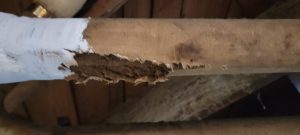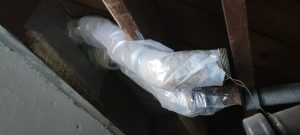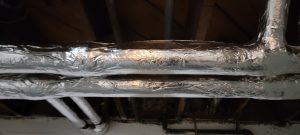Does Your Minneapolis Duplex Have Asbestos?

Friable asbestos wrap on pipe
If you own a duplex or home in the Twin Cities built before 1980, it may have been built with asbestos-containing material.
Asbestos is a naturally occurring mineral that was used in many building products to improve fire and heat resistance and durability.
Does that mean you should gut your property? No. Asbestos is harmful when it is in what’s called friable condition. Friable is generally defined as material containing asbestos that can be crushed, crumbled or pulverized with the touch of a human hand. This can cause the dangerous particulates in it to become airborne and inhaled. Once in a person’s lungs, asbestos has been known to contribute to lung disease, mesothelioma and lung cancer.

Asbestos incorrectly encapsulated in plastic
The place I most frequently see asbestos is wrapped around the pipes in basements of duplexes built before 1940. White or dusty tan and cloth-like in appearance, it almost looks like a cast a doctor would put on a broken bone. The majority of it is in good condition. However, friable areas almost look like cut-off blue jeans.
This piping is usually found below the floor joists in the basement; usually where residents do laundry and property owners have a workbench and tools.
The best way to determine if something contains more than 1% asbestos is to buy a test kit at your local hardware store. If the test is positive, the next step is to encapsulate it.

Asbestos incorrectly encapsulated in aluminum foil
There’s a right way and many wrong ways I’ve seen this done. Encapsulate does not mean you should wrap it up in plastic. Nor does it mean you should wrap it up in a towel, or like a baked potato covered in aluminum wrap.
The correct method of encapsulation it is to go to the local hardware store and pick up material made for the job. Like paint, you simply roll it over the affected areas, thereby keeping the particulates from becoming airborne.
Of course, when working with asbestos, it is important to wear an N-100 respirator so as not to inhale the particulates.
And if you’re thinking of just removing the wrap, it is generally best left to someone who does asbestos abatement for a living. The materials are considered harmful and must be removed and disposed of in a proper manner. This includes using plastic sheeting to separate the area, wetting the material down, then double-bagging it in 6-millimeter plastic bags. Those must then be placed in a leak-proof plastic container with a lid and labeled, then disposed of in a landfill that accepts asbestos.
Of course, clothing worn during the procedure must also be decontaminated.
In other words, try to encapsulate it properly. And if it’s too far gone, hire a professional. If you need a recommendation, give me a call.

